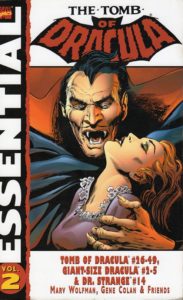Comic Book Review: Essential Tomb of Dracula, Volume 2 mostly written by Marv Wolfman and art by Gene Colan.
When the Comics Code restrictions on horror were loosened in the 1970s, DC primarily went in for horror anthology comics, while Marvel Comics based entire series around horrific heroes and villains. One of these was the classic (and public domain) character of Vlad Tepes, aka Count Dracula.
This series revealed that Bram Stoker’s book (highly recommended if you haven’t read it, by the way) was highly fictionalized, and Dracula had not in fact finally died at the end of it, only being very inconvenienced. He had been various places, doing various things, temporarily being put of commission now and then…and this storyline opened with him once again being awakened to start his reign of terror anew.
Opposing the Lord of Vampires was a crew of vampire hunters including Quincy Harker (the son of Jonathan and Mina), now an elderly man confined to a wheelchair by injuries received in past battles with Dracula; Rachel van Helsing (great-granddaughter of Professor van Helsing) a crossbow-wielder who wasn’t always as effective as she’d like; Frank Drake, a descendant of Dracula (before becoming a vampire) who had wasted his wealth and had to man up over the course of the series; and Taj Nital, an Indian man who had been rendered mute when Dracula injured his throat. Independent of them were Blade, who only hunted Dracula because he hated all vampires due to the murder of his mother by Deacon Frost, and Hannibal King, a detective that Deacon Frost had turned into a vampire, who avoided taking blood from living humans.
Of course, Dracula didn’t just have vampire hunters after him, but people who either wanted to become lord of all vampires themselves or otherwise exploit him. The most persistent of these was Doctor Sun, a Chinese scientist who’d been turned into a disembodied brain hooked up to a computer, who wanted to take over the world.
At the start of this volume, Dracula learns of the current whereabouts of an artifact called the Chimera, which re-sparks his desire to conquer the world himself. (He’d had to put that on hold as a vampire army large enough to take over would promptly drink the rest of humanity to extinction, and then where would they be?) Fortunately for the world, Dracula is not the only one after the artifact, and it ends up smashed.
Dracula has noticed his powers waning, and this leads him to a near-final confrontation with Quincy Harker, before learning that it is in fact Doctor Sun behind it, and the action moves to Boston. There the cast adds nebbish “true vampire story” writer Harold H. Harold and lovely but ditsy secretary Aurora Rabinowitz, who act as comic relief.
After the Doctor Sun situation is resolved, Dracula takes control of a local Satanist cult and marries a woman named Domini, who he believes will give him a proper heir. (The leader of the Satanists, of course, has other plans.)
Mixed throughout this volume are soap-opera subplots involving the various supporting cast, and interludes of Dracula’s adventures in other times and places. Marv Wolfman’s writing is often excellent, but he sometimes doesn’t consult previous issues, resulting in some minor continuity glitches. Gene Colan’s art is more consistently outstanding, and fits the mood well, especially in this black and white reprint. (Some stories from the Giant-Size side series are included, with art by the less impressive but very competent Don Heck.)
Make no mistake, Dracula is the main villain here, and rare is the issue where he does not murder at least one innocent person just to remind us of that. Much of his time is taken up with petty revenge against people who have crossed him and when he acts against other villains, it’s usually out of pride or personal vendetta. Every once in a while, he does show a moment of kindness, but the door soon slams shut when his darker nature prevails. Because he’s the title character, Dracula has what TV Tropes calls “Joker Immunity”; he can never be permanently killed off, only temporarily thwarted, so the heroes seem ineffectual. (Quincy Harker broods about this frequently.)
These stories do take place in the Marvel Universe, though this series avoids most of the implications of that. Brother Voodoo helps Frank Drake through a bad patch in his life, and Doctor Strange actually temporarily kills Dracula (but is hypnotized not to notice it’s not permanent until later.)
In addition to the expected violence (but relatively little gore–the Comics Code was still in effect), Dracula’s attacks on women are often treated in a sexualized manner. There are some instances of suicide, both voluntary and forced. Dracula is also depicted as being racist (mostly against Blade) and sexist (he is not at all kind to the memory of Lucy Westerna.)
And speaking of sexism, one story includes a woman who’s a bit of a “straw feminist”; the owner of a fashion house who only hires women even if a man would be more competent at the job (except one dress designer who might be gay given the coding) and who has an enormous grudge against the various men who tried to keep her down. Dracula agrees to kill her enemies in exchange for information she can get more efficiently than he, but leaves her in a sticky situation at the end of the story.
Despite often high melodrama, there are some very well-written moments as well.
Recommended for vampire comics fans, Blade fans who want to see his early adventures, and those who enjoy Gene Colan’s art.

